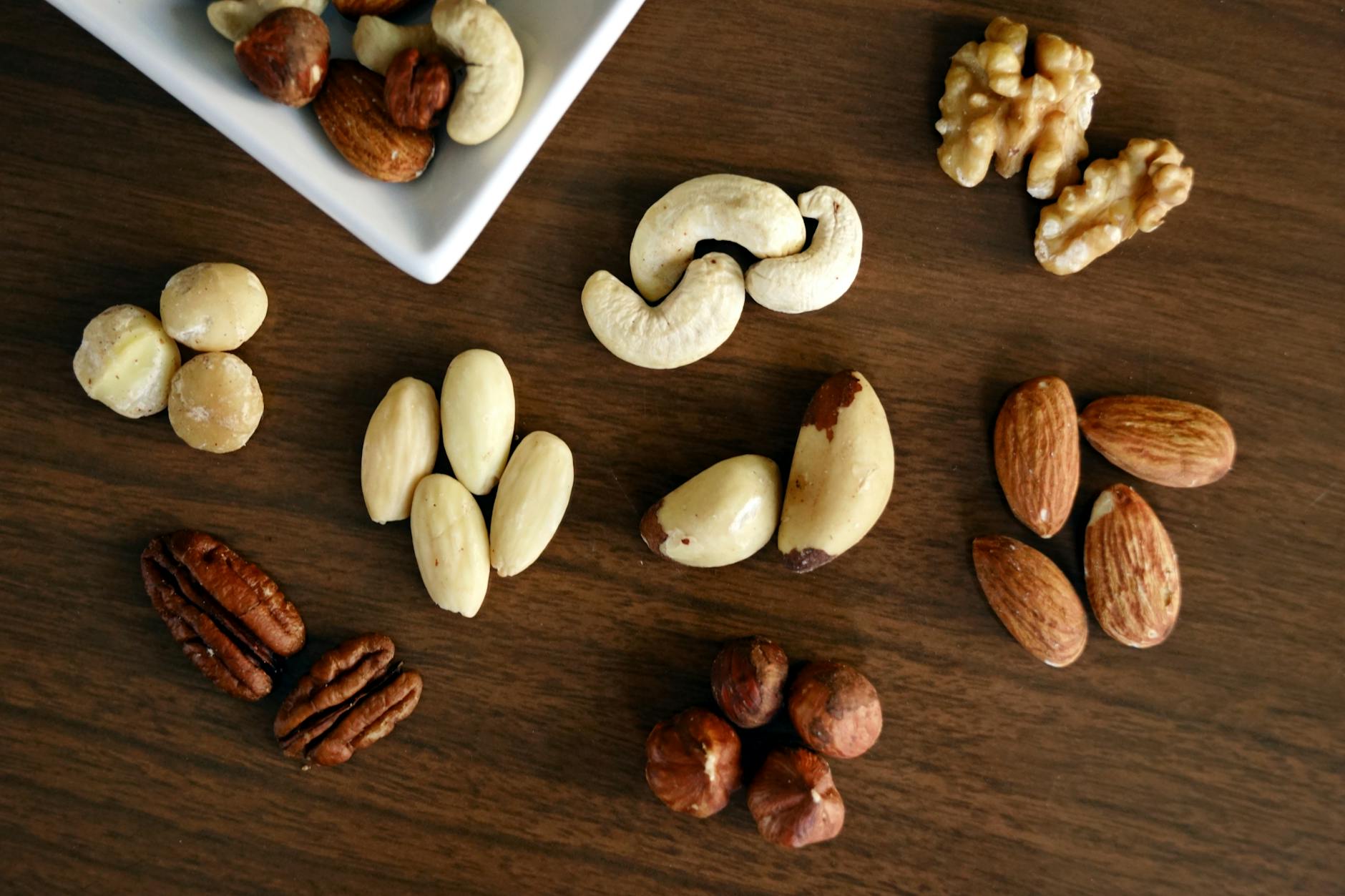Nuts have been part of human diets for centuries, enjoyed across cultures as snacks, cooking staples, and festive treats. Small yet powerful, they pack flavor, crunch, and a wealth of nutrients in every bite. From almonds and walnuts to pistachios and cashews, these versatile foods can be eaten raw, roasted, blended into spreads, or used to enrich both sweet and savory dishes.
This guide explores popular types of nuts, their nutritional highlights, unique characteristics, and easy ways to include them in daily meals.
Why Nuts Deserve a Place in Every Diet
Nuts are nutrient-dense foods filled with healthy fats, protein, fiber, vitamins, and minerals. Most varieties are rich in unsaturated fats, known to support heart health, as well as antioxidants that help protect the body from oxidative stress.
Regular nut consumption has been linked to:
- Improved heart health
- Lower cholesterol levels
- Reduced risk of type 2 diabetes
- Enhanced brain function
- Better weight management
Whether sprinkled on a salad, blended into creamy butters, or eaten by the handful, nuts are among the simplest and most convenient ways to boost nutrition.
1. Almonds
Mildly sweet and widely consumed, almonds are among the most versatile nuts. They can be eaten raw, roasted, or transformed into almond milk, butter, or flour.
Nutritional Highlights:
- Rich in vitamin E, magnesium, and fiber
- Packed with heart-healthy monounsaturated fats
- A reliable source of protein
How to Use:
- Add to granola or trail mixes
- Blend into smoothies or milk alternatives
- Sprinkle over salads for crunch
2. Walnuts
Recognized for their unique, brain-like shape, walnuts are linked to cognitive health. Their rich, earthy flavor makes them ideal for both baking and savory dishes.
Nutritional Highlights:
- Excellent source of omega-3 fatty acids (ALA)
- Loaded with antioxidants and polyphenols
- Supports memory and brain function
How to Use:
- Toss into oatmeal or yogurt
- Mix into brownies or banana bread
- Enjoy raw as a nutritious snack
3. Cashews
Creamy and buttery, cashews are a favorite in both snacks and vegan cooking, where they blend seamlessly into sauces and dairy substitutes.
Nutritional Highlights:
- Good source of copper, magnesium, and zinc
- Lower in fat compared to many other nuts
- Supports bone and heart health
How to Use:
- Blend into vegan cheese or cashew cream
- Add to stir-fries and curries
- Eat roasted and lightly salted
4. Pistachios
Known for their signature shells and green kernels, pistachios offer a sweet, nutty flavor. They are often used in desserts and Middle Eastern dishes.
Nutritional Highlights:
- High in protein and fiber
- Rich in vitamin B6 and potassium
- Contains lutein and zeaxanthin for eye health
How to Use:
- Snack on roasted pistachios
- Bake into cookies or cakes
- Add to pilafs or pestos
5. Hazelnuts
Sweet and earthy, hazelnuts are famous for their role in chocolate spreads but also shine in savory cooking.
Nutritional Highlights:
- Rich in vitamin E and folate
- Good source of manganese and copper
- Supports skin and heart health
How to Use:
- Use in nut butters and spreads
- Incorporate into baked goods
- Roast and toss into salads
6. Pecans
Native to North America, pecans are buttery and rich, making them perfect for pies and holiday treats.
Nutritional Highlights:
- High in antioxidants
- Contains thiamine and manganese
- Provides monounsaturated fats for heart health
How to Use:
- Bake into pecan pie or muffins
- Mix with granola or yogurt
- Snack on roasted pecans with spices
7. Macadamia Nuts
Native to Australia, macadamia nuts are creamy and luxurious, often regarded as a gourmet snack.
Nutritional Highlights:
- Rich in monounsaturated fats
- Contains manganese and thiamine
- Promotes satiety and heart health
How to Use:
- Eat roasted or salted
- Add to cookies or confections
- Use macadamia oil for cooking
8. Brazil Nuts
Large and nutrient-dense, Brazil nuts are famous for being one of the richest natural sources of selenium.
Nutritional Highlights:
- Exceptionally high in selenium (supports thyroid health)
- Provides magnesium and vitamin E
- Boosts immune function
How to Use:
- Eat one or two daily to meet selenium needs
- Chop into baked goods
- Mix into nut blends
⚠️ Caution: Overconsumption can lead to excess selenium intake.
9. Pine Nuts
Often used in Mediterranean cuisine, pine nuts have a delicate, buttery flavor and are essential in pesto.
Nutritional Highlights:
- Good source of vitamin K, magnesium, and iron
- Heart-healthy monounsaturated fats
- Provides energy and protein
How to Use:
- Blend into pesto
- Toast lightly and add to salads
- Sprinkle on pasta dishes
10. Chestnuts
Chestnuts are unique for being lower in fat and higher in carbohydrates, giving them a starchy, sweet flavor.
Nutritional Highlights:
- High in vitamin C
- Lower in fat than most nuts
- Provides antioxidants and fiber
How to Use:
- Roast for a warm seasonal snack
- Use in soups, stuffings, or desserts
- Grind into flour for gluten-free baking
11. Peanuts (Legumes with Nut Qualities)
Though technically legumes, peanuts are grouped with nuts due to their similar nutrition and culinary uses.
Nutritional Highlights:
- High in protein and niacin
- Contains resveratrol, a potent antioxidant
- Affordable and accessible source of healthy fats
How to Use:
- Make peanut butter
- Add to stir-fries or Asian noodle dishes
- Enjoy roasted, salted, or boiled
Practical Hacks for Eating Nuts
- Portion Control: Nuts are calorie-dense. Stick to a handful (about 28g or 1 ounce) for snacking.
- Storage Tips: Keep nuts in airtight containers. Refrigeration helps extend freshness.
- Soaking: Soak almonds overnight to improve digestibility.
- Mix It Up: Create custom nut blends for both flavor and nutrition.
Beyond Nutrition: Lifestyle Benefits
Nuts don’t just fuel the body—they can also improve mental well-being. Their crunch provides satisfaction, making them ideal for mindful snacking. Organized nut jars in the kitchen also help reduce clutter, promoting a sense of balance and calm.
Conclusion
Nuts are some of nature’s most compact superfoods—nutritious, versatile, and delicious. Each type offers something unique, from the selenium-rich Brazil nut to the protein-packed almond. They fit easily into vegan, vegetarian, and omnivorous diets, making them a universal pantry staple.
Enjoying nuts in moderation, while storing them properly, ensures both health and flavor benefits. Whether in salads, desserts, or as a quick snack, these little powerhouses can elevate everyday eating into something both healthy and satisfying.
Disclaimer
This article is for informational purposes only and not intended as medical advice. Those with nut allergies or specific health concerns should consult a healthcare professional before making dietary changes.



